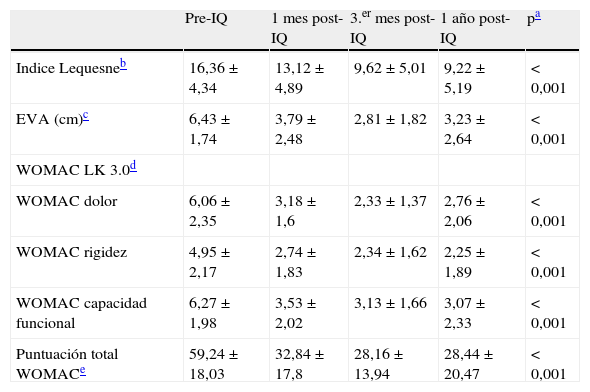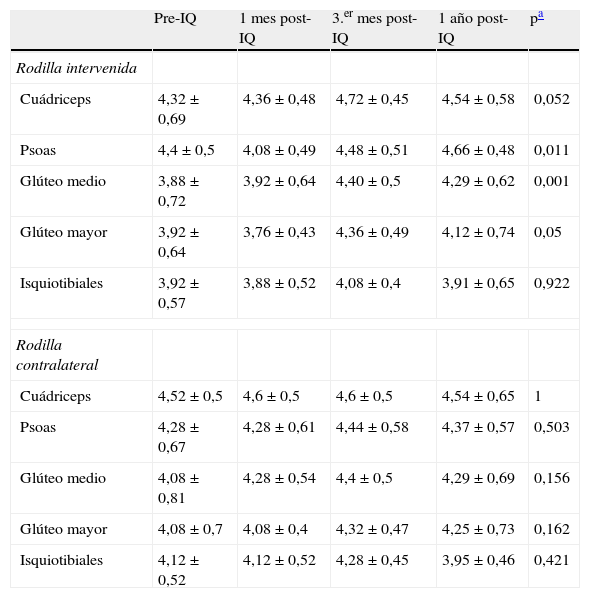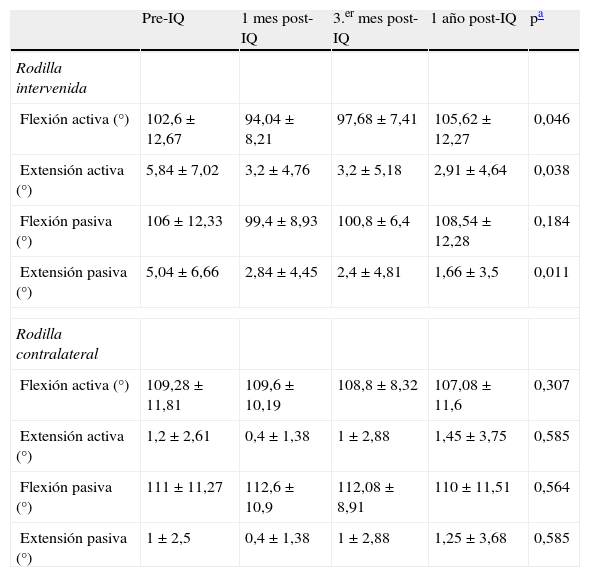El objetivo de este estudio fue determinar la existencia de factores predictivos de resultado funcional tras la intervención de artroplastia total primaria de rodilla (ATPR).
Material y métodosEstudio prospectivo con 25 pacientes, pendientes de ATPR, con fecha prevista de cirugía, candidatos a seguir el proceso rehabilitador en el servicio de medicina física y rehabilitación de nuestro hospital. Se valoró a los pacientes una semana antes de la cirugía, al mes, a los 3 meses y al año. Las variables recogidas fueron: sexo, edad, dolor, balance articular y balance muscular de ambas rodillas, índice de Lequesne y cuestionario de WOMAC. En la primera visita, se calculó el índice de masa corporal (IMC) de cada paciente. En cada valoración, se evaluó la capacidad funcional de los pacientes mediante los tests: prueba de la marcha de los 6min (PM6), Timed Up and Go test (TUG) y Stair Climbing Test (SCT).
ResultadosTras la ATPR existe una mejora en los parámetros analizados. En la valoración previa a la cirugía, el IMC y la valoración muscular de cuádriceps y glúteo medio de la rodilla afecta pueden considerarse como factores predictivos del resultado de las pruebas de capacidad funcional al año de la intervención.
ConclusionesLa ATPR es una intervención eficaz en el tratamiento de la gonartrosis. El IMC, el balance muscular y la capacidad funcional previos a la cirugía pueden considerarse como factores predictivos de resultados funcionales al año de la intervención.
The aim of this study was determine the existence of predictive factors of the functional level after primary total knee arthroplasty (PTKA).
Material and methodsA prospective study of 25 patients on the waiting list of PTKA, with foreseen date of surgery and candidates to follow the rehabilitating process in the department physical medicine and rehabilitation of our hospital was performed. The patients were evaluated one week before the arthroplasty, and at one month, three months and one year after surgery. The variables registered in each evaluation were sex, age, pain, range of movement and muscular balance of the surgical and nonsurgical knees and the results of Lequesne index and WOMAC questionnaire. In the first evaluation, body mass index (BMI) was calculated. In each visit, functional ability was evaluated by the 6-Minute Walking Test (6M-WT), Time Up and Go test (TUG) and a timed Stair Climbing Test (SCT).
ResultsAfter PTKA, there is an improvement in the analyzed parameters. In the evaluation before surgery, the BMI and the muscular balance of quadriceps femoris and gluteus medius of surgical knee can be considered as predictors of the results of functional capacity tests at one year of the arthroplasty.
ConclusionsPTKA is a good treatment for the knee osteoarthritis. The BMI, muscular balance and functional ability in the preoperative evaluation can be considered as predictors of the functional level one year after PTKA.











